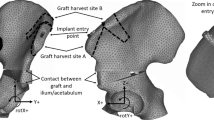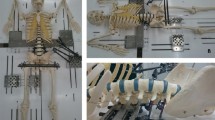Abstract
Customized prostheses are normally employed to reconstruct the biomechanics of the pelvis after resection due to tumors or accidents. The objective of this study is to evaluate the biomechanics of the pelvis under different daily activities and to establish a functional evaluation methodology for the customized prostheses. For this purposes, finite element model of a healthy pelvis as well as a reconstructed pelvic model after type II+III resection were built for biomechanical study. The biomechanical performance of the healthy and reconstructed pelvic model was studied under routine activities including standing, knee bending, sitting down, standing up, walking, stair descent and stair ascent. Subsequently, the strength and stability of the prosthesis were evaluated under these activities. Results showed that, for the heathy pelvic model, the stresses were mainly concentrated around the upper part of the sacrum and the sacroiliac joint undergoing different activities, and the maximum stress occurred during stair ascent. As for the reconstructed pelvis, the stress distribution and the tendency of the maximum stress variation predicted for the bone part during all the activities were similar to those of the natural pelvic model, which indicated that the load transferring function of the reconstructed pelvis could be restored by the prosthesis. Moreover, the predicted maximum von Mises stress of the screws and prosthesis was below the fatigue strength of the 3D printed Ti-6Al-4V, which indicated the prosthesis can provide a reliable mechanical performance after implantation.
Similar content being viewed by others
References
Phillips A T M, Pankaj P, Howie C R, Usmani A S, Simpson A H R W. Finite element modelling of the pelvis: Inclusion of muscular and ligamentous boundary conditions. Medical Engineering & Physics, 2007, 29, 739–748.
Jia Y W, Cheng L M, Yu G R, Du C F, Yang Z Y, Yu Y, Ding Z Q. A finite element analysis of the pelvic reconstruction using fibular transplantation fixed with four different rod-screw systems after type I resection. Chinese Medical Journal, 2008, 121, 321–326.
Liu D X, Hua Z K, Yan X Y, Jin Z M. Design and biomechanical study of a novel adjustable hemipelvic prosthesis. Medical Engineering & Physics, 2016, 38, 1416–1425.
Wang B, Sun P D, Xie X B, Wu W D, Tu J, Ouyang G J, Shen J N. A novel combined hemipelvic endoprosthesis for peri-acetabular tumours involving sacroiliac joint: A finite element study. International Orthopaedics, 2015, 39, 2253–2259.
Bus M P A, Campanacci D A, Albergo J I, Leithner A, Van de Sande M A J, Michiel A J, Gaston C L, Caff G, Mettelsiefen J, Capanna R, Tunn P U. Conventional primary central chondrosarcoma of the pelvis. The Journal of Bone and Joint Surgery, 2018, 100, 316–325.
Noakes K F, Bissett I P, Pullan A J, Cheng L K. Anatomically realistic three-dimensional meshes of the pelvic floor & anal canal for finite element analysis. Annals of Biomedical Engineering, 2008, 36, 1060–1071.
Ji T, Guo W, Tang X D, Yang Y. Reconstruction of type II+III pelvic resection with a modular hemipelvic endoprosthesis: A finite element analysis study. Orthopaedic Surgery, 2010, 2, 272–277.
Iqbal T, Shi L, Wang L, Liu Y X, Li D C, Qin M, Jin Z M. Development of finite element model for customized prostheses design for patient with pelvic bone tumor. Journal of Engineering in Medicine, 2017, 231, 525–533.
Zhou Y, Min L, Liu Y, Shi R, Zhang W L, Zhang H, Duan H, Tu C Q. Finite element analysis of the pelvis after modular hemipelvic endoprosthesis reconstruction. International Orthopaedics, 2013, 37, 653–658.
Kitagawa Y, Ek E T, Choong P F M. Pelvic reconstruction using saddle prosthesis following limb salvage operation for periacetabular tumour. Journal of Orthopaedic Surgery, 2006, 14, 155–162.
Donati D, D’Apote G, Cevolani L, Benedetti M G. Clinical and functional outcomes of the saddle prosthesis. Journal of Orthopaedics & Traumatology, 2012, 13, 79–88.
Aljassir F, Beadel G P, Turcotte R E, Griffin A M, Bell R S, Wunder J S, Isler M H. Outcome after pelvic sarcoma resection reconstructed with saddle prosthesis. Clinical Orthopaedics & Related Research, 2005, 438, 36–41.
Issa S P, Biau D, Babinet A, Dumaine V, Hanneur M L, Anract P. Pelvic reconstructions following peri-acetabular bone tumour resections using a cementless ice-cream cone prosthesis with dual mobility cup. International Orthopaedics, 2018, 42, 1987–1997.
Liu D X, Hua Z K, Yan X Y, Jin Z M. Biomechanical analysis of a novel hemipelvic endoprosthesis during ascending and descending stairs. Journal of Engineering in Medicine, 2016, 230, 962–975.
Zhao X, Xiao J L, Sun Y, Zhu Z, Xu M, Wang X N, Lin F F, Wang Y B, Wang J C. Novel 3D printed modular hemipelvic prosthesis for successful hemipelvic arthroplasty: A case study. Journal of Bionic Engineering, 2018, 15, 1067–1074.
Wang B, Xie X B, Yin J Q, Zou C Y, Wang J, Huang G, Wang Y Q, Shen J N. Reconstruction with modular hemipelvic endoprosthesis after pelvic tumor resection: A report of 50 consecutive cases. PLoS One, 2015, 10, e0127263
Ying T, Ma R Y, Ming Y, Wang D M, Wang C T. Rapid prototyping fabrication and finite element evaluation of the three-dimensional medical pelvic model. International Journal of Advanced Manufacturing Technology, 2006, 28, 302–306.
Guo W, Li D S, Tang X D, Yang Y, Ji T. Reconstruction with modular hemipelvic prostheses for periacetabular tumor. Clinical Orthopaedics & Related Research, 2007, 461, 180–188
García J M, Doblaré M, Seral B, Seral F, Palanca D, Gracia L. Three-dimensional finite element analysis of several internal and external pelvis fixations. Journal of Biomechanical Engineering, 2000, 122, 516–522
Dong E C, Ling W, Iqbal T, Li D C, Liu Y X, He J K, Zhao B H, Li Y. Finite element analysis of the pelvis after customized prosthesis reconstruction. Journal of Bionic Engineering, 2018, 15, 443–451
Hao Z X, Wan C, Gao X F, Ji T. The effect of boundary condition on the biomechanics of a human pelvic joint under an axial compressive load: A three-dimensional finite element model. Journal of Biomechanical Engineering, 2011, 8, 965–979
Fan Y P, Lei J Y, Zhu F, Li Z Q, Chen W Y, Liu X M. Biomechanical analysis of the fixation system for T-shaped acetabular fracture. Computational & Mathematical Methods in Medicine, 2015, 2015, 370631.
Zhou Y, Min L, Liu Y, Shi R, Zhang W L, Zhang H, Duan H, Tu C Q. Finite element analysis of the pelvis after modular hemipelvic endoprosthesis reconstruction. International Orthopaedics, 2013, 37, 653–658
Volinski B, Kalra A, Yang K. Evaluation of full pelvic ring stresses using a bilateral static gait-phase finite element modeling method. Journal of the Mechanical Behavior of Biomedical Materials, 2017, 78, 175–187.
Iqbal T, Wang L, Li D C, Dong E C, Fan H B, Fu J, Hu C. A general multi-objective topology optimization methodology developed for customized design of pelvic prostheses. Medical Engineering and Physics, 2019, 69, 8–16.
Leung A S O, Gordon L M, Skrinskas T, Szwedowski T, Whyne C M. Effects of bone density alterations on strain patterns in the pelvis: Application of a finite element model. Proceedings of the Institution of Mechanical Engineers, Part H: Journal of Engineering in Medicine. 2009, 223, 965–979
Hao Z X, Wan C, Gao X F, Ji T, Wang H S. The effect of screw fixation type on a modular hemi-pelvic prosthesis: A 3-D finite element model. Disability & Rehabilitation Assistive Technology, 2013, 8, 125–128
Andersen R C, O’Toole R V, Nascone J W, Sciadini M F, Frisch H M, Turen C W. Modified stoppa approach for acetabular fractures with anterior and posterior column displacement: Quantification of radiographic reduction and analysis of interobserver variability. Journal of Orthopaedic Trauma, 2010, 24, 271–278
Bergmann G, Graichen F, Rohlmann A. Hip joint loading during walking and running, measured in two patients. Journal of Biomechanics, 1993, 26, 969–990
Mann R W. Comment on: Hip contact forces and gait patterns from routine activities. Journal of Biomechanics, 2002, 35, 719–720
Reilly D T, Burstein A H. The Mechanical properties of cortical bone. Journal of Bone and Joint Surgery, 1974, 56, 1001–1022
Greitemeier D, Palm F, Syassen F, Melz T. Fatigue performance of additive manufactured TiAl6V4 using electron and laser beam melting. International Journal of Fatigue, 2017, 94, 211–217
Hosseini S, Hudak R, Penhaker M, Majernik J. Fatigue of Ti-6Al-4V. Biomedical Engineering Technical Applications in Medicine, 2012, 17, 75–92
Zhao S, Li S J, Hou W T, Hao Y L, Yang R, Misra R D K. The influence of cell morphology on the compressive fatigue behavior of Ti-6Al-4V meshes fabricated by electron beam melting. Journal of the Mechanical Behavior of Biomedical Materials, 2016, 59, 251–264
Hedayati R, Janbaz S, Sadighi M, Mohammadi-Aghdam M, Zadpoor A A. How does tissue regeneration influence the mechanical behavior of additively manufactured porous biomaterials? Journal of the Mechanical Behavior of Biomedical Materials, 2017, 65, 831–841
Dumas M, Terriault P, Brailovski V. Modelling and characterization of a porosity graded lattice structure for additively manufactured biomaterials. Materials & Design, 2017, 121, 383–392
Simoneau C, Brailovski V, Terriault P. Design, manufacture and tensile properties of stochastic porous metallic structures. Mechanics of Materials, 2016, 94, 26–37
Wang L, Kang J F, Sun C N, Li D C, Cao Y, Jin Z M. Mapping porous microstructures to yield desired mechanical properties for application in 3D printed bone scaffolds and orthopaedic implants. Materials & Design, 2017, 133, 62–68
Long M, Rack H J. Titanium alloys in total joint replacement— A materials science perspective. Biomaterials, 1998, 19, 1621–1639.
Acknowledgment
The work was supported by the Program of the National Key R&D Program of China (2018YFC11067000), National Key R&D Program of China (2018YFB1107000), Key R&D Program of Guangdong Province (2018B090906001), the Key Program of International Cooperation in Shaanxi Province (2017KW-ZD-02), the Fundamental Research Funds for the Central Universities and the Youth Innovation Team of Shaanxi Universities, Project of Scientific Research of Shaanxi (2016SF-136).
Author information
Authors and Affiliations
Corresponding authors
Rights and permissions
About this article
Cite this article
Dong, E., Iqbal, T., Fu, J. et al. Preclinical Strength Checking for Artificial Pelvic Prosthesis under Multi-activities - A Case Study. J Bionic Eng 16, 1092–1102 (2019). https://doi.org/10.1007/s42235-019-0121-5
Published:
Issue Date:
DOI: https://doi.org/10.1007/s42235-019-0121-5




